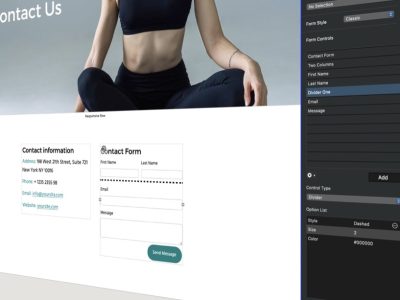When you start a new website project in EverWeb it’s easy just to dive straight in with developing your new site. Although it’s tempting to start work and correct any mistakes later, that’s often an approach that will cost you more time, effort and money in the long run. So, take a few minutes up front to set up your project file before you get down to business and save yourself hassle further along the line. Here are our tips on how to get ahead when you create a new EverWeb website project file…
- Always name your project file When you create a new project file, it’s named ‘NEW WEBSITE’ by default. To change this to something that better reflects your project, double click on ‘NEW WEBSITE’ in the Web Page List and change the name. Press Enter when done. Alternatively you can also use the File-> Rename Website menu command.
- Create a Backup plan. EverWweb includes its own Backup and Auto Save features under the EverWeb-> Preferences menu. Backup can store up to 50 backup versions of your Project file which is great if you ever need to roll back your project to a certain point in time. You can also schedule when backups of your Project files take place in addition to your regulator computer backups.
EverWeb’s Auto Save feature saves your work regularly when the Project file is being edited. This is a useful, for example, if your computer crashes you will only have lost the last few keystrokes of work.
- Check the other EverWeb Preferences. Whilst you’re in EverWeb’s Preferences, check out General and Publishing tabs and set the defaults you want.
- Set up Default Styles. Before you start to work on your project, you should have done some groundwork on your website’s fonts and color choices. Use the Format-> Default Styles menu to set the font name, size and color. You can also change the default Shape color and stroke as well. The defaults for Hyperlinks states can be set by editing any of the options that start with the word ‘Link’.
- Also something that you may want to consider before starting your project is which objects will you be using on all of your pages? For example, a Navigation Menu widget, company logo, page background color etc. may be better in a Master Page rather than creating the same objects on every page. Master Pages save you so much time and effort and add a consistency to every page of your site.
- Install all of the web browsers you need on your computer. When it comes to testing your website, it’s always good to see how your pages will look in all of the main web browsers such as Google Chrome, Apple Safari, Mozilla Firefox, Opera and Microsoft Internet Explorer/Edge. Remember that there are also mobile browsers. Many desktop web browsers features that simulate a mobile environment to make testing easier for us all! Some users may also want to use the Apple’s Simulator program that comes as part of Xcode to simulate various iPhone and iPad models.
When installing a new web browser on your computer, make it should be located in the Applications folder. Once you’ve installed your web browsers launch EverWeb and click on the Preview button, or use the File-Preview menu app to see them all listed for use.
- Install any fonts that you need for your project. As you probably know already, your macOS comes with only a few web safe fonts. These fonts ensure compatibility across different operating systems and web browsers. Expanding your choice of fonts is easy using e.g. Google Fonts. Just install the fonts you want and off you go! There are many other third party font providers out there as well but always check out their licensing and compatibility across desktop and mobile operating systems upfront before purchasing.
- Add any third party widgets that you may want to use to your computer system. Some third party widgets are offered free, some are chargeable. The best place to find third party widgets is from the EverWeb Addons page of the EverWeb website.
- Check for Theme Template updates. if you are stuck for a design for your website, Theme Templates can be the answer! EverWeb includes over 100 designs built in with more added with new product releases. Check the EverWeb-> Check for New Templates… menu to find out if you’re up to date. There are also third party template suppliers too, the EverWeb Addons page has the links to these resources.
- When you start working in EverWeb it’s easy to initially overlook the need to set up your Publishing Settings, but that’s easy to fix. Just click on your project file name in the Web Page List, or use the File-> Edit Publishing Settings menu option. EverWeb’s editing workspace will be replaced by the Site Publishing Settings screen where you can enter in your Publishing location details whether you have an EverWeb+Hosting account (recommended!) or host with your own Hosting Provider. Use the ‘Publish To’ drop down to select where you want your site published to. If necessary you may need to work with your Hosting Provider if you are not sure of the details to enter in the Site Publishing Settings.
- The last tip when setting up EverWeb for your first project file is to check for updates to EverWeb itself. Use the EverWeb-> Check for Update… menu option to see if you have the latest release of EverWeb installed. EverWeb itself can periodically check for updates if you have ‘Automatically Check for Updates’ box in the Account tab of the EverWeb-> Preferences menu checked.
Using the above tips will help getting started with your project much easier and quicker. You’ll save time and will have fewer issues to sort out later on just by taking a few minutes to set things up at the start of your project!









Comments